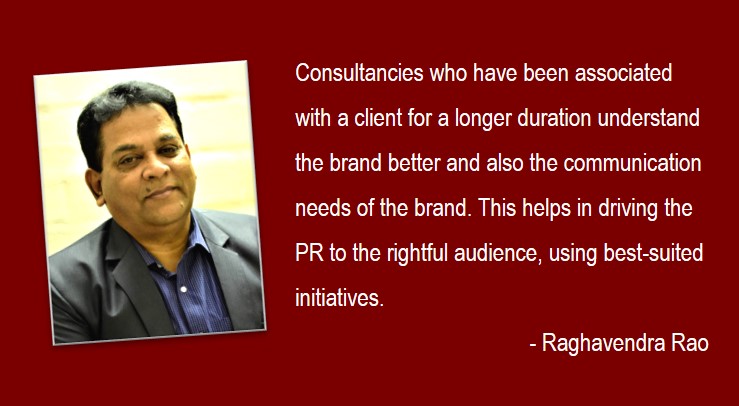Historically we have seen that unlike other outsourced services, PR is very close to the heart of the top management and is closely monitored. There are also less frequent shifts from one consultancy to another as it is considered as a critical management function and sharing of information to outside is vulnerable. We also notice that the other outsourced activities of major clients like advertising, direct marketing and even social media changes hands too often. The same is not true for PR, as large and even critical information is shared with the PR teams. Information which is very sensitive to brands and matters a lot and therefore calls for a longer association.
Hence, large brands continue their relationship with PR consultancies for a longer duration and also become an integral part of the clients’ PR process and systems. Consultancies who have been associated with a client for longer durations also understand the brand better and also the communication needs for the brand. Ultimately the consultancy understands the brand and its needs and also drives the PR to the rightful audience with initiatives as follows:
- Earned media takes its rightful place: There’s a lot of talk about the PESO model of Paid, Earned, Shared and Owned media. However, building relationships that lead to significant earned coverage is still top of mind for business leaders who understand that good coverage lends hand to credibility and building public confidence. Capturing positive sentiment is what makes earned media so powerful―It’s not what I say; it’s what others say, think, and feel. With so many voices online and in social media communities, the opportunity for earned media has undoubtedly expanded.
- Brand health and reputation matter: Are there executives who don’t have reputation and brand health on their minds? Every communication, at every touchpoint, affects how the public views a brand, and building, maintaining and protecting a brand’s reputation has always been in PR’s wheelhouse. PR pros are often referred to as The Brand Police for their work in reputation management, their efforts to preserve the health of the brand and to keep the public “cup of goodwill” full.
- Ethics are top of mind: New technology can heighten consumer concerns and fears. Do you remember any of your colleagues in the 1990s questioning whether or not email should be for everyone in the company? The response, in some circles, was that it should only be for senior leadership. The type of technology often isn’t what matters; it’s the change it brings, how it’s used and the level of transparency involved in using it. Today’s business leaders can rely on their PR teams to apply an ethical approach to Artificial Intelligence. As AI is used increasingly in marketing and customer service, leaders need to ensure it’s used to build trust, its identity is not concealed and the technology is helpful to consumers. If you thought social media challenged ethical communication, AI and other new technologies are pushing the envelope even further. Business leaders will look to PR and communication professionals who can be the voice of reason in the room and those who practice communications with a conscience.
- Good storytelling cuts through the clutter: Connecting PR and good storytelling is easy. PR can bring the credibility factor as PR storytelling should come from an objective point of view. Business leaders rely on PR professionals to guide them on why a story will or will not work, once again serving as the voice of reason. Today’s public relations professionals are marrying the creative art of storytelling with data intelligence to back up why a story needs to be told. They also have a good idea of how the public will respond based on their data intelligence. PR continues to sharpen its social media listening skills, understanding how people rally around stories that lead to increased brand awareness. PR pros also know how to optimise stories and content for greater engagement that can lead to increased sales and customer advocacy.
- You’re one step away from crisis communications: Years ago, crisis was reserved for specific industries. If you took an in-house position in a hotel or restaurant chain, or perhaps the travel industry, then you were likely signing up for a job in crisis communications. Today, any company can experience crisis, and it’s one step closer to you than you think. The Internet prompted crisis preparedness when news cycles shortened, and as people complained and shared negative experiences online, 24/7. With the arrival of social media, PR had to rethink the crisis players, channels, messaging and monitoring and how they handled crisis communications through all media.
Business leaders recognise how earned media coverage can also come from trusted influencers, social media peers and their own customer champions. Customers can be your best advocates when you’re exceeding their expectations and providing them with the best experiences. But corporates are adopting the power of PR as an accelerator of change, which can have benefits across multiple audiences including company staff. Moving towards sustainability can have remarkable results.
As someone who works in public relations I have a vested interest in saying that PR has a role to play in accelerating progress on sustainability.
Here are my top three tips for getting it right:
- Set and communicate a clear direction on sustainability, which liberates people throughout your organisation to talk passionately and freely about what you’re doing. They are your best advocates.
- Be transparent about your motives. Business needs to pursue business objectives if any initiative is to be sustainable. Don’t let PR wrap your business motives in cloying half stories about the social good your business is driving.
- Tell the story of the journey. Be open about what’s not working as much as what is. Vulnerability plays surprisingly well with sustainability, stakeholders and a cynical public.
The views expressed here are that of the author and do not necessarily reflect that of Reputation Today.



Be the first to comment on "PR services – Trust between client & media"